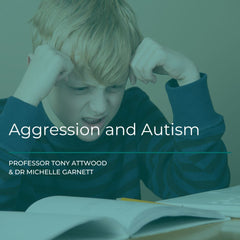Autism and Aggression

As clinicians, we are often asked to advise on supporting autistic people with the expression of anger and aggression. This request can come from parents, teachers, a partner and autistic people themselves. For example, an eight-year-old autistic child once asked, “Please can you help me manage my temper, it gets me into trouble, I break things that are expensive, and other children avoid me as my temper scares them”.
Although anger is often viewed as destructive, from an evolutionary psychology perspective, it has provided several adaptive advantages that have helped humans survive. Anger activates the body to defend against threats, acts as a deterrent to aggressors, protects resources, signals refusal to accept unfair treatment, and helps enforce social boundaries. It also provides energy to persist in challenging or frustrating tasks. Aggression can be a form of communication, conveying frustration, pain or unmet needs. While anger is usually directed outward to a person or object, it can also be directed inward through self-injurious actions, particularly for autistic people with experience difficulties with spoken communication (Giacomo et al, 2016).
Our clinical experience and research suggest that around 50% of autistic people may experience challenges with aggression at some point, regardless of intellectual or language abilities (Elkhamisi & Almutery, 2018; Caamano et al, 2013). For some, these difficulties can persist for many years (Laverty et al, 2023).
While anger and aggression have survival value, autistic people may experience more intense anger and find anger harder to regulate. This can relate to differences in neurology, experiences of anxiety and depression, the cognitive profile associated with autism, environmental stressors, and co-occurring conditions such as ADHD.
Neurology
Autism is often associated with difficulties perceiving internal bodily states (Interoception), identifying and describing feelings (Alexithymia), and regulating the intensity of these feelings (Amygdala-related processes).
Neuroimaging research has identified structural and functional differences in the amygdala in autistic people (Andrews et al., 2022). The amygdala is involved in recognising and regulating emotions, particularly anger, anxiety and sadness. Autistic people may experience a heightened sensitivity to perceived threats and a stronger emotional response. There is also evidence of reduced connectivity between the amygdala and the frontal lobes, which support cognitive regulation of emotions (Rausch et al, 2016).
Interoceptive differences may also make it harder for some autistic people to notice early signs of rising agitation, such as increased heartbeat, changes in breathing, muscle tension, or raised voice volume. As an autistic child explained, “My brain doesn’t tell me soon enough,” and an autistic adult reflected, “I only know what I am feeling by seeing what I am doing.”
This helps explain why some autistic children and adults do not appear consciously aware of increasing emotional stress. There may be few internal or external warning signs until emotions have become overwhelming. At this point, cognitive strategies for self-control may be less effective, and behaviour may appear to erupt “out of the blue.”
Anxiety
Around 86% of autistic people report daily difficulties with anxiety (Attwood, Evans and Lesko, 2014). Anxiety and aggression have been linked in autistic adolescents (Ambler et al, 2015; Ostrovska & Ostrovskii, 2018). When we are consulted about aggression, we often first consider whether high anxiety and a fight–flight–freeze response are underlying factors.
Change and uncertainty are well-known triggers of anxiety for autistic people. Predictability through routines, rituals, or engaging in deeply focused interests can help reduce anxiety. When access to these supports is blocked, frustration can build and escalate into agitation or aggression.
Our clinical experience suggests that emotional meltdowns can act as a “discharge” of anxious energy, with some autistic people reporting “I feel better now” afterwards. Psychologists describe this as negative reinforcement, where the reduction of distress strengthens the likelihood of repeating the behaviour as a regulation strategy.
Another way of reducing anxiety is by seeking greater control over daily life. While this can be protective, it may also contribute to conflict within families if needs for control clash, leading to heightened tension and anger expression.
Depression
Depression or low mood affects around 75% of autistic children, adolescents, and adults (Attwood, Evans and Lesko, 2014; Kim & Lecavalier, 2021). Feelings of rejection, loneliness, peer criticism, limited access to positive change, and painful sensory experiences can all contribute. Autistic people may also feel undervalued or invalidated by peers, adding to despair.
In some cases, sadness is expressed outwardly as anger. For example, in a group of autistic teenagers asked how they show sadness, some described crying or walking alone, while others described breaking objects, playing violent video games, or hitting a pillow. One teenage girl said, “Crying doesn’t work for me, so I get angry instead and throw sticks.” For her, physical expression helped release sadness. Unfortunately, such behaviour can be misinterpreted solely as aggression. This highlights the importance of distinguishing anger that arises from anxiety or depression from anger that is primarily reactive, as the approach to support may differ.
Cognitive Profile
Autistic people may sometimes misinterpret others’ facial expressions, attributing negative intent where none was intended (Eack et al, 2015; Kirst et al, 2021). In these situations, aggression may serve as a defensive response.
Emotion regulation strategies such as cognitive reappraisal (reframing a situation to reduce emotional impact) may be less commonly used. Reduced cognitive flexibility can also reduce perceived options for resolving social difficulties. For example, if an autistic child is teased and attempts to ignore it, ask for it to stop, or tell an adult, but these do not succeed, they may eventually resort to an intense display of anger to end the experience.
Autistic adolescents also report higher levels of anger-focused rumination than their peers (Patel et al, 2017). Prolonged rumination may escalate distress and increase the likelihood of aggressive responses as a means of resolution.
Environmental factors
Sensory overload from sounds, lights, or smells can trigger fight-or-flight responses, leading to intense emotional reactions (Rinaldo & Perry, 2023).
Masking or camouflaging distress at school or work can also result in accumulated emotional strain that is released later at home. Families may perceive a sharp contrast between behaviour in public and at home, without recognising the emotional cost of masking.
Difficulties with conflict resolution, perspective-taking, and negotiation can increase interpersonal stress. Past trauma, including bullying, invalidation, or abuse, can also heighten vulnerability to aggressive reactions in triggering situations.
ADHD
Up to 70% of autistic people also have ADHD (Rong et al, 2021). Impulsivity, a core feature of ADHD, can make it difficult to pause before responding when angry. Some people act immediately without the chance to consider alternative strategies and potential outcomes.
A subgroup of children with ADHD have been described as having emotion regulation difficulties (ERD), characterised by irritability, low distress tolerance, strong emotional reactions, and impulsivity (Faraone et al, 2019; Martel, 2009). Autistic people with ADHD may also show this profile, compounding challenges with anger regulation.
Summary
Aggression in autistic people arises from a complex interplay of neurological, emotional, cognitive, environmental, and co-occurring conditions. It often reflects difficulties in regulating strong emotions in the face of anxiety, depression, sensory overload, or impulsivity. It is essential to recognise that aggression can serve as a coping strategy or communication of distress, not a character flaw.
Where to from here?
If you would like to deepen your understanding and gain practical strategies for supporting autistic people with anger and aggression, we recommend our on-demand course Aggression and Autism.
In this 60-minute session, you will:
- Learn to recognise the background stressors and early warning signs of rising agitation
- Explore how to tailor responses depending on motive, environment and abilities
- Develop a clear safety plan and strategies to reduce risk during aggressive episodes
- Walk away with tools you can apply at home, school, or in clinical practice
Includes a recorded presentation, downloadable resources, CPD certificate and 60 days access to the recording.
References
Ambler, P. G., Eidels, A., & Gregory, C. (2015). Anxiety and aggression in adolescents with autism spectrum disorders attending mainstream schools. Research in Autism Spectrum Disorders, 18, 97-109.
Attwood, T., Evans, C., and Lesko, A. (2014). Been There. Done That. Try This!’ Jessica Kingsley Publishers.
Andrews, D. S., Aksman, L., Kerns, C. M., Lee, J. K., Winder-Patel, B. M., Harvey, D. J., ... & Amaral, D. G. (2022). Association of amygdala development with different forms of anxiety in autism spectrum disorder. Biological psychiatry, 91(11), 977-987.
Brown, C., Borduin, C., Sheerin, K., & Kanne, S. (2024). Characteristics and correlates of aggressive behavior in autistic youths. Autism Research, 17(8), 1586-1600. https://doi.org/10.1002/aur.3199
Caamaño, M., Boada, L., Merchán-Naranjo, J., Moreno, C., Llorente, C., Moreno, D., ... & Parellada, M. (2013). Psychopathology in children and adolescents with ASD without mental retardation. Journal of autism and developmental disorders, 43(10), 2442-2449.
Eack, S. M., Mazefsky, C. A., & Minshew, N. J. (2015). Misinterpretation of facial expressions of emotion in verbal adults with autism spectrum disorder. Autism, 19(3), 308-315.
Elkhamisi, E. and Almutery, M. (2018). Aggression dimensions in students with autism. European Scientific Journal Esj, 14(9), 330. https://doi.org/10.19044/esj.2018.v14n9p330
Faraone, S. V., Rostain, A. L., Blader, J., Busch, B., Childress, A. C., Connor, D. F., & Newcorn, J. H. (2019). Practitioner Review: Emotional dysregulation in attention‐deficit/hyperactivity disorder–implications for clinical recognition and intervention. Journal of child psychology and psychiatry, 60(2), 133-150.
Giacomo, A., Craig, F., Terenzio, V., Coppola, A., Campa, M., & Passeri, G. (2016). Aggressive behaviors and verbal communication skills in autism spectrum disorders. Global Pediatric Health, 3. https://doi.org/10.1177/2333794x16644360
Gohari, H. K. Schiltz, and C. Lord, "A Longitudinal Study of Aggression in People with Autism and Other Neurodevelopmental Disabilities," Journal of Autism and Developmental Disorders, 2024.
Holingue, C., Poku, O., Pfeiffer, D., Murray, S., & Fallin, M. (2021). Gastrointestinal concerns in children with autism spectrum disorder: a qualitative study of family experiences. Autism, 26(7), 1698-1711. https://doi.org/10.1177/13623613211062667
Imbiriba, T., Demirkaya, A., Singh, A., Erdoğmuş, D., & Goodwin, M. (2023). Wearable biosensing to predict imminent aggressive behavior in psychiatric inpatient youths with autism. Jama Network Open, 6(12), e2348898. https://doi.org/10.1001/jamanetworkopen.2023.48898
Kim, S. Y., & Lecavalier, L. (2021). Depression in young autistic people: A scoping review. Research in Autism Spectrum Disorders, 88, 101841.Kirst, S., Bögl, K., Gross, V., Diehm, R., Poustka, L., & Dziobek, I. (2021). Subtypes of aggressive behavior in children with autism in the context of emotion recognition, hostile attribution bias, and dysfunctional emotion regulation. Journal of Autism and Developmental Disorders, 52(12), 5367-5382. https://doi.org/10.1007/s10803-021-05387-wMartel, M. M. (2009). Research review: A new perspective on attention‐deficit/hyperactivity disorder: Emotion dysregulation and trait models. Journal of Child Psychology and Psychiatry, 50(9), 1042-1051.
Оstrovska, K. and Ostrovskii, I. (2018). Aggressiveness of adolescents with autism with different levels of school anxiety. Visnyk of the Lviv University Series Pedagogics, (33), 174-185. https://doi.org/10.30970/vpe.2018.33.9966
Patel, S., Day, T. N., Jones, N., & Mazefsky, C. A. (2017). Association between anger rumination and autism symptom severity, depression symptoms, aggression, and general dysregulation in adolescents with autism spectrum disorder. Autism, 21(2), 181-189.
Rausch, A., Zhang, W., Haak, K. V., Mennes, M., Hermans, E. J., van Oort, E., ... & Groen, W. B. (2016). Altered functional connectivity of the amygdaloid input nuclei in adolescents and young adults with autism spectrum disorder: a resting state fMRI study. Molecular autism, 7(1), 13.
Rinaldo, E. and Perry, A. (2023). Associations of age, anxiety, cognitive functioning, and social impairment with aggression in youth with autism. Research in Autism Spectrum Disorders, 108, 102246. https://doi.org/10.1016/j.rasd.2023.102246
Rong, Y., Yang, C. J., Jin, Y., & Wang, Y. (2021). Prevalence of attention-deficit/hyperactivity disorder in individuals with autism spectrum disorder: A meta-analysis. Research in Autism Spectrum Disorders, 83, 101759.
Samson, A. C., Hardan, A. Y., Lee, I. A., Phillips, J. M., & Gross, J. J. (2015). Maladaptive behavior in autism spectrum disorder: The role of emotion experience and emotion regulation. Journal of autism and developmental disorders, 45(11), 3424-3432.

